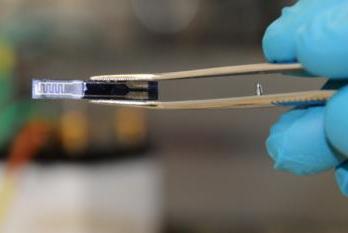New composite material works as CO2 sensor

ZURICH, Switzerland, June 8 (UPI) -- Material scientists in Switzerland have polymer-nanoparticle composite capable of measuring carbon dioxide concentrations. The new device works as effectively as other CO2 sensors, but it is smaller and simpler.
The device derives its abilities the CO2-attracting properties of a polymer of salts called ionic liquids. The ionic liquids aren't actually liquids at all. The chain-like macromolecules are composed of solid salts, which have a range of potential applications.
To see if the polymer could work as a CO2 sensor, researchers at ETH Zurich and the Max Planck Institute of Colloids and Interfaces, in Potsdam, Germany, began combining the material with a variety of other CO2-attracting inorganic nanoparticles. They found a specific combination became conductive when interacting with carbon dioxide.
"Separately, neither the polymer nor the nanoparticles conduct electricity," Christoph Willa, a doctoral student and material scientist at ETH Zurich's Laboratory for Multifunctional Materials, said in a press release. "But when we combined them in a certain ratio, their conductivity increased rapidly."
"We think that CO2 effects the mobility of the charged particles in the material," added Dorota Koziej, the lab's team leader.
What makes the discovery so promising is the fact that the chemical-induced conductivity happened at room temperature.
"Until now, chemoresistive materials have displayed these properties only at a temperature of several hundred degrees Celsius," explained Koziej.
A simpler, more compact CO2 sensor has a variety applications, researchers say, including the improvement of breathing-air measurement devices for scuba diving and extreme altitude mountaineering. The technology could also bolster a number of medical devices.
